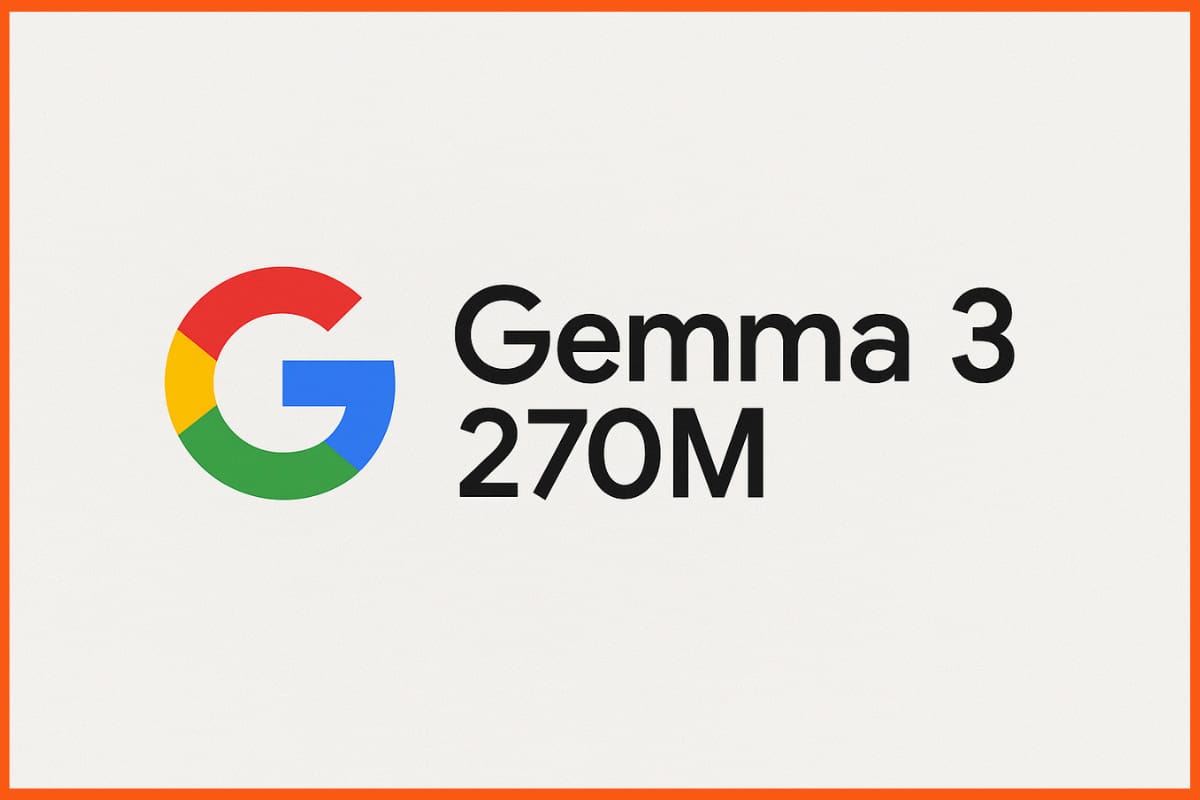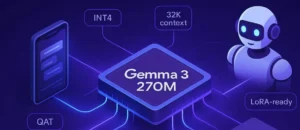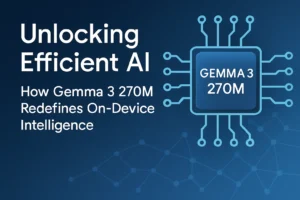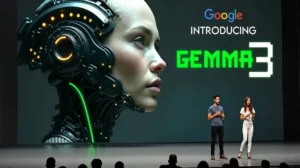Google’s Gemma 3 270M — the tiny titan for on-device and edge AI
When people talk about “bigger is better” in large language models, Google quietly pushed a different message: intelligence doesn’t always require billions of parameters — sometimes it requires smarter design and careful engineering. Enter Gemma 3 270M, a compact, 270-million-parameter member of Google’s Gemma 3 family built for hyper-efficient on-device and edge deployments while still offering strong instruction-following and fine-tuning potential. The model is explicitly aimed at developers and researchers who need a lightweight, practical base model that can be adapted to specific tasks, run on modest hardware, and maintain respectable capability for many real-world uses. Google Developers Blog+1
What is Gemma 3 270M?
Gemma 3 is Google’s family of “Gemma” models — openish models that incorporate learnings from Google’s Gemini research — designed to be multimodal, multilingual, and available in a range of sizes so developers can choose the best tradeoffs for their hardware and use cases. The Gemma 3 lineup spans from very small (270M) to large (tens of billions of parameters). The 270M variant is the smallest Gemma 3 release and was designed with an explicit emphasis on efficiency, on-device viability, and task-specific fine-tuning. Google AI for Developers+1
Unlike monolithic models that aim to be “one model to rule them all,” Gemma 3 270M is engineered to be a robust base for customization. Google’s documentation highlights that Gemma 3 models are multimodal (text + image input with text output), support long contexts, and come in multiple parameter sizes to fit different performance and resource requirements. The 270M model keeps the core capabilities while dramatically shrinking memory and compute needs — enabling usage patterns that were previously impractical for smaller devices. Hugging Face+1
Key architectural and engineering notes
Several engineering decisions make Gemma 3 270M stand out:
-
Parameter split & vocab design: Google reports that the model’s 270M parameters include a large portion dedicated to embeddings (a consequence of a very large token vocabulary) along with a compact set of transformer parameters for reasoning and generation. This choice improves handling of rare and specialized tokens without dramatically growing the transformer compute. Google Developers Blog+1
-
Large token/vocabulary support: To better capture domain-specific and rare tokens (technical terms, product SKUs, multilingual tokens), Gemma 3 270M uses an unusually large vocabulary. That design enables better tokenization for specialized domains at small model sizes. Google Developers Blog
-
Quantization-aware training and INT4 friendliness: A major focus for the 270M variant is running at very low precisions (e.g., INT4) with minimal accuracy loss. This dramatically reduces memory footprint and enables real-time performance on mobile and embedded accelerators when suitably quantized. Several community writeups and tutorials note that an INT4 or other aggressive quantization of the 270M produces practical on-device RAM requirements. DataCamp+1
-
Multimodality & trimmed vision stack: While larger Gemma 3 sizes incorporate advanced vision encoders (e.g., SigLIP in bigger variants), the 270M focuses primarily on text capabilities and lightweight multimodal understanding appropriate for edge use. The family design lets developers pick the size that matches their vision + language needs. Google Developers Blog+1
Where Gemma 3 270M shines — practical use cases
Because of its tight balance of compactness and capability, Gemma 3 270M is well suited to several real-world scenarios:
-
On-device assistants and mobile features. Apps that provide conversational assistants, summarization, or privacy-sensitive features can run a quantized Gemma 3 270M locally — reducing latency, cutting cloud costs, and improving privacy by avoiding constant server roundtrips. Community testing suggests a properly quantized version can run acceptably on modern flagship phones and modest laptops. bdtechtalks.substack.com+1
-
Domain-specific fine-tuning for verticals. Because the model is intentionally designed for task-specific fine-tuning, teams building chatbots for technical support, medical triage (with clinical oversight), legal drafting templates, or product recommendation engines can adapt the compact 270M model quickly without the infrastructure cost of fine-tuning huge models. Tutorials and developer guides highlight quick fine-tuning workflows and demo projects built around the 270M variant. DataCamp+1
-
Edge robotics, IoT, and wearables. Robotics controllers, voice UI on wearables, and IoT devices that need natural-language understanding but have strict power/compute budgets can use Gemma 3 270M with appropriate quantization and pruning strategies. Google DeepMind
-
Research & education. The relatively small size and lower resource barrier make Gemma 3 270M attractive for academic experiments and teaching, where students can explore fine-tuning, prompt engineering, and evaluation without a cluster of GPUs. Google’s academic initiatives around Gemma aim to reduce entry friction for researchers. The Verge+1
Performance and tradeoffs
The 270M model intentionally trades some generalist capability for efficiency and adaptivity. In head-to-head benchmark comparisons, larger Gemma 3 variants outperform the smallest model on complex reasoning and multimodal tasks, but the 270M delivers excellent performance per watt and per byte for many common tasks when fine-tuned or used with instruction tuning. In short:
-
Pros: tiny memory footprint when quantized, faster inference on single accelerator devices, cheap to fine-tune, and ideal for latency-sensitive applications. bdtechtalks.substack.com+1
-
Cons: reduced zero-shot reasoning on very complex multi-step problems compared to 12B+ models; limited onboard vision capacity compared to larger Gemma variants. Google Developers Blog
Developers therefore must choose Gemma 3 270M when their constraints prioritize on-device inference, cost, and customization over raw generalist capabilities.
Licensing, availability, and the developer ecosystem
Google released Gemma 3 models with an eye toward broad developer access, but not unconditional permissiveness. The models have been distributed under Google’s Responsible Generative AI licensing terms (and related programmatic access options), with availability through major distribution platforms such as Hugging Face and direct channels for cloud/edge deployment. Several community hubs, demos, and tutorials also surfaced quickly after the announcement, reflecting strong developer interest. Google has coupled access with programs and credits for academic research in some cases. Hugging Face+2Hirecade+2
Practical availability notes:
-
Hugging Face & model hubs: Pretrained weights and instruction-tuned variants for Gemma 3 270M appear on major model hubs for easy experimentation. Hugging Face
-
Google tooling & docs: Google’s Gemma docs and developer pages outline model sizes, quantization options, and integration pathways (Gemini API, AI Studio, and cloud offerings). Google AI for Developers+1
Because of licensing limits, production usage should be checked against Google’s license text to ensure compliance with permitted use cases — particularly in regulated or sensitive domains.
Getting started — practical tips for engineers
If you want to experiment with Gemma 3 270M, here’s a condensed “first steps” checklist:
-
Pick your platform. Try the model first on a cloud Jupyter or local workstation using Hugging Face or Google’s examples. For mobile/edge testing, use quantization workflows that target INT4/INT8 formats. Hugging Face+1
-
Quantize early — but evaluate. Convert a checkpoint to INT8/INT4 carefully and validate on held-out tasks. Quantization dramatically reduces RAM and inference time but requires evaluation for accuracy regressions. Many community guides show nearly seamless results for common NLP tasks. bdtechtalks.substack.com+1
-
Instruction-tune or fine-tune for your task. The 270M model is designed to accept task-specific fine-tuning. For chatbots or instruction agents, a small dataset of high-quality instruction examples can yield major improvements. Hugging Face
-
Measure latency, memory, and tokenization effects. Because Gemma 3 270M emphasizes a large vocabulary, tokenization behavior may differ from smaller vocabulary models — monitor token counts and costs in production. Google Developers Blog
-
Safety & evaluation. Use content filters and model safety tools in front of user-facing applications. While Google’s family includes safety classifiers and research on misuse risk, responsible deployment still requires human oversight and domain-appropriate guardrails. The Verge+1
Ethical and safety considerations
Compact models lower the barrier to deployment and therefore increase the number of contexts where an LLM might run — including consumer devices with limited moderation capabilities. That creates both opportunities (privacy, responsiveness) and risks (unchecked generation, misuse). Google and the community emphasize:
-
Safety classifiers and filters for image and text inputs to reduce harmful outputs. Larger Gemma variants include dedicated vision safety classifiers; smaller variants should pair with external safety pipelines. Google Developers Blog+1
-
Responsible licensing and programmatic access that place usage constraints and provide academic or research credits, intended to steer use toward constructive applications. Always review the license for your use case. Hirecade
-
Human-in-the-loop oversight in sensitive domains (medical, legal, safety-critical systems) — the 270M model is a useful assistive tool but not a replacement for subject-matter experts.
Community reaction and comparisons
The developer and research communities reacted quickly: discussions on forums and technical blogs highlighted the excitement over a genuinely usable, small, quantization-friendly model that could run on a phone or a single GPU. Comparisons typically position Gemma 3 270M as one of the more polished small models available from a major lab — with the advantage of Google’s engineering, documentation, and ecosystem support. Commentators note that while it doesn’t replace higher-capacity models for complex reasoning or high-fidelity multimodal work, it excels in the “deploy anywhere” bucket. Medium+1
Future directions — what to watch
-
Improved quantization toolchains. Expect better tooling and community recipes for INT4/INT8 that maintain more of the original model quality while shrinking memory usage further. bdtechtalks.substack.com
-
Smaller multimodal upgrades. As vision encoders get more efficient, future sub-billion models may incorporate stronger image understanding while staying deployable on edge hardware. Google Developers Blog
-
Ecosystem integrations. Wider availability in on-device runtimes (Ollama-style local runtimes, LM Studio, mobile SDKs) and cloud pipelines will make it trivial to prototype and then scale. Hirecade+1
Verdict — when to pick Gemma 3 270M
Choose Gemma 3 270M when your product or research needs:
-
Low latency on constrained hardware (phones, low-end GPUs).
-
Cheap and fast fine-tuning for domain tasks.
-
On-device inference for privacy or offline operation.
-
A pragmatic tradeoff where model size, energy, and cost matter more than the last percent of accuracy on complex reasoning.
If you require state-of-the-art zero-shot multi-step reasoning, large scale multimodal generation, or the strongest benchmarks across the board, a larger Gemma 3 variant (4B, 12B, 27B) or other large models will still perform better. But for many real products — chat assistants, mobile NLP features, edge analytics pipelines, and classroom experiments — the 270M model is a game changer: tiny enough to run where users are, but smart enough to be useful with modest customization. Google AI for Developers+1
Further reading & resources
For official technical notes, release timelines, and developer guides check Google’s Gemma docs and blog posts, and the Gemma 3 270M page on major model hubs which include checkpoints and quickstart examples. The community has already published hands-on tutorials and demos showing mobile/Android demos, quantization recipes, and fine-tuning walkthroughs. Google Developers Blog+2Hugging Face+2
For quick updates, follow our whatsapp channel –https://whatsapp.com/channel/0029VbAabEC11ulGy0ZwRi3j
https://bitsofall.com/https-yourblog-com-diella-albanias-first-ai-made-minister/






